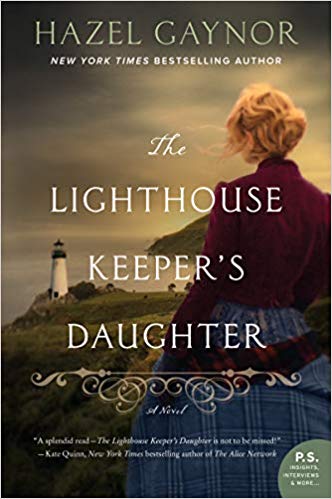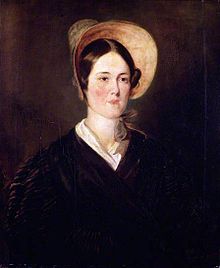 The Lighthouse Keeper's Daughter by Hazel Gaynor
The Lighthouse Keeper's Daughter by Hazel Gaynor Format: eARC
Source: supplied by publisher via Edelweiss
Formats available: hardcover, paperback, large print, ebook, audiobook
Genres: historical fiction
Pages: 383
Published by William Morrow Paperbacks on October 9, 2018
Purchasing Info: Author's Website, Publisher's Website, Amazon, Barnes & Noble, Kobo, Bookshop.org
Goodreads
From The New York Times bestselling author of The Girl Who Came Home comes a historical novel inspired by true events, and the extraordinary female lighthouse keepers of the past two hundred years.
“They call me a heroine, but I am not deserving of such accolades. I am just an ordinary young woman who did her duty.”
1838: Northumberland, England. Longstone Lighthouse on the Farne Islands has been Grace Darling’s home for all of her twenty-two years. When she and her father rescue shipwreck survivors in a furious storm, Grace becomes celebrated throughout England, the subject of poems, ballads, and plays. But far more precious than her unsought fame is the friendship that develops between Grace and a visiting artist. Just as George Emmerson captures Grace with his brushes, she in turn captures his heart.
1938: Newport, Rhode Island. Nineteen-years-old and pregnant, Matilda Emmerson has been sent away from Ireland in disgrace. She is to stay with Harriet, a reclusive relative and assistant lighthouse keeper, until her baby is born. A discarded, half-finished portrait opens a window into Matilda’s family history. As a deadly hurricane approaches, two women, living a century apart, will be linked forever by their instinctive acts of courage and love.
My Review:
The Lighthouse Keeper’s Daughter might have been more appropriately titled if the apostrophe had been in a different place. Because this isn’t the story of one lighthouse keeper’s daughter, but instead about two lighthouse keepers’ daughters, living in lighthouses both a century and an ocean apart.
As the story opens, we aren’t sure what links our two heroines – although we certainly do find out.
In 1838 on the coast of Northumberland, Grace Darling is the daughter of the keeper of the Longstone Lighthouse on Farne Island. As a woman, she can’t officially be the assistant lighthouse keeper, or have a hope of inheriting the duties of the lighthouse keeper from her father, but she loves the lighthouse and the work every bit as much as her father and her brothers do.
In the midst of a terrible, Grace, that night’s lookout, sees survivors of a shipwreck clinging to a “so near but yet so far” rock. The storm will sweep those pitiful survivors away if Grace and her father can’t get to them. But the storm is more than capable of sweeping Grace, her father and their tiny boat away if they try.
That trying turns Grace into a heroine, rowing the boat with her father and holding it against the storm as he helped the few survivors into the boat. Her heroism made a her national heroine, and brought her unwanted attention for the rest of her life.
In 1938, Mathilda Emmerson has been sent from her home in Ireland to Newport, Rhode Island, to the care of her cousin Harriet Flaherty, herself the lighthouse keeper in Newport. Mathilda is in disgrace, having fallen pregnant after a night of indiscretion. Her mother intends for her to have the child in America, leave it behind, and return to her life as the dutiful daughter of a politician.
In Mathilda’s possession is Grace Darling’s book of procedures of lighthouse keeping, and her locket. The items have been passed down in her family from mother to daughter for the past century.
Through the eyes of Grace in the 19th century and Mathilda in the 20th, we learn how Grace’s book made its way from Northumberland to Ireland to America, and finally about the ties that bind these two women from such different times and places.
And that those ties are much closer than Mathilda ever thought.
Escape Rating B: For this reader, this was ultimately a sad book, and is both heartbreaking and heartwarming at points. But it felt to me as if the sadness wins out. I think how a reader will feel about this will depend on which of the two women one ends up identifying with. I found Grace’s story to be ultimately tragic. I identified with her strong desire to find and keep a sense of purpose, but I wanted better for her than she had.
Her doomed romance felt like a bit of a misunderstandammit to me. They did love each other, they would have been happy together, but neither of them could break out of the restrictions of their time to actually say anything.

As fiction, it felt disappointing. Discovering afterwards that Grace’s part of the book is based on a true story, and that the real Grace Darling never married and died young as she does in the book, makes her part of the story make more sense.
I still wish she’d had a happier ending, or was a bit less of the tragic romantic heroine.
Matilda’s story is the one that is supposed to stick with the reader, and its ending is ultimately hopeful, albeit bittersweet. She does come into her own as the lighthouse keeper, but not until after some rather melodramatic family business that was foreshadowed more than a little bit. And, in keeping with the tone of the book, she has to suffer her own tragedy before she triumphs.
For a story that is for the most part rather quiet – giant storms notwithstanding – the story is very readable and pulls the reader along, or rather back and forth across time and the ocean, from one protagonist to another.
Discovering that Grace Darling was a real historical figure was quite a surprise after finishing the book. They say that truth is stranger than fiction. While her life isn’t stranger than fiction, it certainly made for an interesting story.






















I like your take on the title – it makes sense!
Thanks for being on the tour.